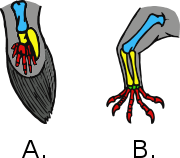Pennaraptora
| Pennaraptorans Temporal range: Late Jurassic–Present, 160–0 Ma | |
|---|---|
 | |
| Cast skeleton of Conchoraptor gracilis | |
.jpg) | |
| House sparrow (Passer domesticus) | |
| Scientific classification | |
| Kingdom: | Animalia |
| Phylum: | Chordata |
| Class: | Reptilia |
| Clade: | Dinosauria |
| Order: | Saurischia |
| Suborder: | Theropoda |
| Clade: | Maniraptora |
| Clade: | Pennaraptora Foth et al., 2014 |
| Subgroups | |
Pennaraptora is a clade defined as the most recent common ancestor of Oviraptor philoceratops, Deinonychus antirrhopus, and Passer domesticus (the house sparrow), and all descendants thereof, by Foth et al., 2014.[1] The earliest known definitive member of this clade is Anchiornis, from the late Jurassic period of China, about 160 million years ago.
The clade "Aviremigia" was conditionally proposed along with several other apomorphy-based clades relating to birds by Jacques Gauthier and Kevin de Queiroz in a 2001 paper. Their proposed definition for the group was "the clade stemming from the first panavian with ... remiges and rectrices, that is, enlarged, stiff-shafted, closed-vaned (= barbules bearing hooked distal pennulae), pennaceous feathers arising from the distal forelimbs and tail".[2]
See also
References
- ↑ Foth, Christian (2014). "New specimen of Archaeopteryx provides insights into the evolution of pennaceous feathers". Nature. 511 (7507): 79–82. doi:10.1038/nature13467. PMID 24990749.
- ↑ Gauthier, J. and de Queiroz, K. (2001). "Feathered dinosaurs, flying dinosaurs, crown dinosaurs, and the name 'Aves'". Pp. 7-41 in Gauthier, J. and L.F. Gall (eds.), New Perspectives on the Origin and Early Evolution of Birds: Proceedings of the International Symposium in Honor of John H. Ostrom. New Haven: Peabody Museum of Natural History, Yale University. ISBN 0-912532-57-2.
